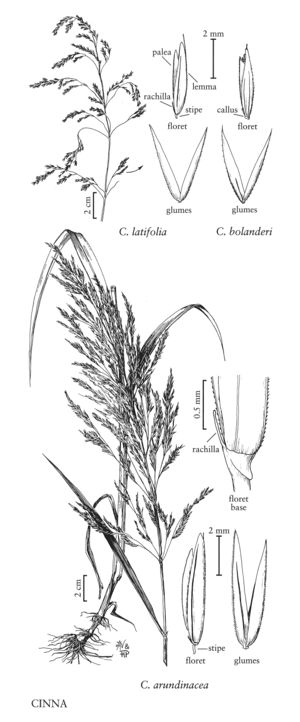Difference between revisions of "Cinna arundinacea"
FNA>Volume Importer |
FNA>Volume Importer |
||
| Line 7: | Line 7: | ||
|synonyms={{Treatment/ID/Synonym | |synonyms={{Treatment/ID/Synonym | ||
|name=Cinna arundinacea var. inexpansa | |name=Cinna arundinacea var. inexpansa | ||
| − | |authority= | + | |authority= |
| + | |rank=variety | ||
}} | }} | ||
|hierarchy=Poaceae;Poaceae subfam. Pooideae;Poaceae tribe Poeae;Cinna;Cinna arundinacea | |hierarchy=Poaceae;Poaceae subfam. Pooideae;Poaceae tribe Poeae;Cinna;Cinna arundinacea | ||
| Line 20: | Line 21: | ||
-->{{Treatment/Body | -->{{Treatment/Body | ||
|distribution=Conn.;N.J.;N.Y.;W.Va.;Del.;D.C;Wis.;N.B.;Ont.;Que.;N.H.;Tex.;La.;Tenn.;N.C.;S.C.;Pa.;Va.;Mass.;Maine;R.I.;Vt.;Ala.;Kans.;N.Dak.;Nebr.;Okla.;S.Dak.;Ark.;Ill.;Ga.;Ind.;Iowa;Md.;Ohio;Mo.;Minn.;Mich.;Mont.;Miss.;Ky. | |distribution=Conn.;N.J.;N.Y.;W.Va.;Del.;D.C;Wis.;N.B.;Ont.;Que.;N.H.;Tex.;La.;Tenn.;N.C.;S.C.;Pa.;Va.;Mass.;Maine;R.I.;Vt.;Ala.;Kans.;N.Dak.;Nebr.;Okla.;S.Dak.;Ark.;Ill.;Ga.;Ind.;Iowa;Md.;Ohio;Mo.;Minn.;Mich.;Mont.;Miss.;Ky. | ||
| − | |discussion=<p>Cinna arundinacea grows in southeastern Canada and throughout most of the eastern United States, at 0-900 m. It is most common in moist woodlands and swamps, depressions, along streams, and in floodplains and upland woods. It is less frequent in wet meadows, marshes, and disturbed sites. It flowers in late summer to fall. Cinna arundinacea is most easily distinguished from C. latifolia by its 3-veined upper glumes and larger spikelets.</p> | + | |discussion=<p><i>Cinna arundinacea</i> grows in southeastern Canada and throughout most of the eastern United States, at 0-900 m. It is most common in moist woodlands and swamps, depressions, along streams, and in floodplains and upland woods. It is less frequent in wet meadows, marshes, and disturbed sites. It flowers in late summer to fall. <i>Cinna arundinacea</i> is most easily distinguished from <i>C. latifolia</i> by its 3-veined upper glumes and larger spikelets.</p> |
|tables= | |tables= | ||
|references= | |references= | ||
| Line 29: | Line 30: | ||
-->{{#Taxon: | -->{{#Taxon: | ||
name=Cinna arundinacea | name=Cinna arundinacea | ||
| − | |||
|authority=L. | |authority=L. | ||
|rank=species | |rank=species | ||
| Line 36: | Line 36: | ||
|basionyms= | |basionyms= | ||
|family=Poaceae | |family=Poaceae | ||
| − | |illustrator=Linda | + | |illustrator=Linda Ann Vorobik;Hana Pazdírková |
| + | |illustration copyright=Utah State University | ||
|distribution=Conn.;N.J.;N.Y.;W.Va.;Del.;D.C;Wis.;N.B.;Ont.;Que.;N.H.;Tex.;La.;Tenn.;N.C.;S.C.;Pa.;Va.;Mass.;Maine;R.I.;Vt.;Ala.;Kans.;N.Dak.;Nebr.;Okla.;S.Dak.;Ark.;Ill.;Ga.;Ind.;Iowa;Md.;Ohio;Mo.;Minn.;Mich.;Mont.;Miss.;Ky. | |distribution=Conn.;N.J.;N.Y.;W.Va.;Del.;D.C;Wis.;N.B.;Ont.;Que.;N.H.;Tex.;La.;Tenn.;N.C.;S.C.;Pa.;Va.;Mass.;Maine;R.I.;Vt.;Ala.;Kans.;N.Dak.;Nebr.;Okla.;S.Dak.;Ark.;Ill.;Ga.;Ind.;Iowa;Md.;Ohio;Mo.;Minn.;Mich.;Mont.;Miss.;Ky. | ||
|reference=None | |reference=None | ||
| Line 42: | Line 43: | ||
|publication year= | |publication year= | ||
|special status= | |special status= | ||
| − | |source xml=https:// | + | |source xml=https://jpend@bitbucket.org/aafc-mbb/fna-data-curation.git/src/f50eec43f223ca0e34566be0b046453a0960e173/coarse_grained_fna_xml/V24/V24_1097.xml |
|subfamily=Poaceae subfam. Pooideae | |subfamily=Poaceae subfam. Pooideae | ||
|tribe=Poaceae tribe Poeae | |tribe=Poaceae tribe Poeae | ||
Revision as of 20:17, 16 December 2019
Culms 28-185 cm, somewhat bulbous at the base; nodes 5-13. Ligules 2-10 mm; blades to 34.5 cm long, 3-19 mm wide. Panicles 6.5-55 cm; branches ascending to spreading. Spikelets (3.5)4-6(7.5) mm; rachilla prolongations 0.1-0.4 mm, sometimes absent. Lower glumes (2.7)3.5-5(6.1) mm, somewhat shorter than the lemmas, 1-veined; upper glumes (3.5)4-6(7.5) mm, equal to or slightly longer than the lemmas, 3-veined; stipes 0.25-0.65 mm; lemmas (2.7)3.5-5(6.4) mm, 3(5)-veined, awns 0.2-1.5 mm, rarely absent; paleas 1-veined; anthers 1, 0.8-1.9 mm. Caryopses 2.1-2.8 mm. 2n = 28.
Distribution
Conn., N.J., N.Y., W.Va., Del., D.C, Wis., N.B., Ont., Que., N.H., Tex., La., Tenn., N.C., S.C., Pa., Va., Mass., Maine, R.I., Vt., Ala., Kans., N.Dak., Nebr., Okla., S.Dak., Ark., Ill., Ga., Ind., Iowa, Md., Ohio, Mo., Minn., Mich., Mont., Miss., Ky.
Discussion
Cinna arundinacea grows in southeastern Canada and throughout most of the eastern United States, at 0-900 m. It is most common in moist woodlands and swamps, depressions, along streams, and in floodplains and upland woods. It is less frequent in wet meadows, marshes, and disturbed sites. It flowers in late summer to fall. Cinna arundinacea is most easily distinguished from C. latifolia by its 3-veined upper glumes and larger spikelets.
Selected References
None.
